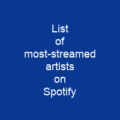Spotify: A Musical Journey Through Time
Imagine a world where music is just a tap away, where every song you love is at your fingertips. That’s the magic Spotify brings to our lives. Founded in 2006 by Daniel Ek and Martin Lorentzon, this Swedish audio streaming service has grown into one of the largest platforms for digital music consumption.
The Rise of a Streaming Giant
Spotify boasts over 675 million monthly active users and 263 million paying subscribers. It operates as a freemium model, offering basic features for free with advertisements and limited control, while additional perks like offline listening and commercial-free music are available through paid subscriptions.
Global Reach
The service is accessible in 184 markets worldwide, making it one of the most widely used platforms. Its presence spans Europe and the United States, but notably, it has no presence in mainland China due to regulatory restrictions.
A Freemium Model with a Purpose
Spotify’s freemium model is designed to balance accessibility and profitability. While free users can enjoy music with ads, paying subscribers get ad-free listening and the ability to create and share playlists without limitations. This dual approach has made Spotify a cornerstone of modern music consumption.
Artists and Royalties
Spotify pays royalties based on artist streams, distributing approximately 70% of its revenue to rights holders who then pay artists according to individual agreements. While some musicians have voiced objections to the service’s royalty structure, others praise it for offering a lawful option to combat piracy and remunerate artists each time their music is played.
From Stockholm to the World
Spotify was founded in Stockholm, Sweden by Ek and Lorentzon in 2006. The company launched internationally in February 2009, followed by the US in July 2011, with various promotional offers and restrictions on the free service tier until its eventual removal in March 2012.
Expansion and Growth
In recent years, Spotify has sought to address concerns about talent recruitment and retention in Sweden by advocating for changes in education policies and stock options. The company expanded its US operations in Lower Manhattan, adding 1,000 jobs and retaining 832 positions.
Breaking Records
‘Thinking Out Loud’ by Ed Sheeran became the first song to pass 500 million streams in October 2015. ‘Lean On’ by Major Lazer and DJ Snake featuring MØ was Spotify’s most-streamed song with over 525 million streams worldwide as of November 2015.
Artist Spotlight
Rihanna became the biggest artist on Spotify, surpassing Justin Bieber, with 31.3 million monthly active listeners in April 2016. Drake briefly surpassed The Weeknd with 36.068 million monthly listeners in December 2016. Taylor Swift’s single ‘Look What You Made Me Do’ broke the record for most single-day streams with over eight million within 24 hours.
Acquisitions and Partnerships
In recent years, Spotify has made several acquisitions to expand its offerings. These include Tunigo, The Echo Nest, Seed Scientific, Cord Project, Soundwave, CrowdAlbum, Preact, Sonalytic, MightyTV, Mediachain, Niland, Soundtrap, Loudr, Gimlet Media and Anchor FM Inc., Parcast, and SoundBetter.
Strategic Moves
The company partnered with PlayStation Music in January 2015 as its exclusive partner. It also announced partnerships with South by Southwest (SXSW) conference, WNYC Studios, and Waze in March 2017. In October 2017, Microsoft ended its Groove Music streaming service and transferred all music to Spotify as part of a new partnership.
Monetization and Controversies
Spotify operates under a freemium business model, generating revenue by selling premium streaming subscriptions to users and advertising placements to third parties. The company has faced criticism for its compensation practices and the impact on artists’ earnings.
Artist Compensation
The median playback latency of Spotify is 265 ms, ensuring a smooth listening experience. However, some computer science and music experts argue that various music communities are often ignored or overlooked by Spotify. The company has been criticized for its lack of diversity within curation staff and potential homogenization of musical styles.
Future Directions
In 2013, Spotify paid artists an average of $0.007 per stream. By 2024, the company had introduced a new royalty model to reduce ‘fraudulent’ royalties. In January 2016, it partnered with Genius and introduced Daily Mix.
Continued Growth
In November 2024, Spotify rebranded its podcasting platform to Spotify for Creators. The company has experimented with different limitations on its Free service tier, including ten hours of music streaming per month and five individual track plays. In January 2014, it removed all time limits for Free users on all platforms.
Conclusion
Spotify’s journey from a small startup in Stockholm to one of the world’s largest music streaming services is nothing short of remarkable. As it continues to evolve and adapt, the question remains: How will Spotify shape the future of music consumption?

You want to know more about Spotify?
This page is based on the article Spotify published in Wikipedia (retrieved on March 12, 2025) and was automatically summarized using artificial intelligence.





